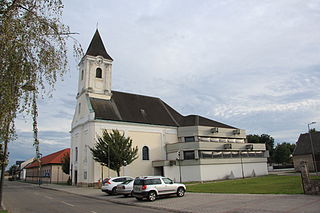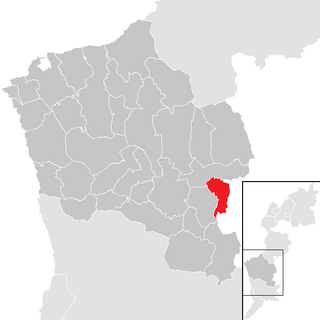
Eisenstadt is the capital city of the Austrian state of Burgenland. With a population of 15,074, it is the smallest state capital and the 38th-largest city in Austria overall. It lies at the foot of the Leitha Mountains hill range.

Güssing is a town in Burgenland, Austria. It is located at 47°4′N16°19′E, with a population of 3,610 (2023), and is the administrative center of the Güssing district. For centuries the town occupied an important position on the western edge of the Kingdom of Hungary. The town is now most famous for its castle, which is the oldest in Burgenland and a prominent regional landmark, built on an extinct volcano.

Neusiedl am See is a town in Burgenland, Austria, and administrative center of the district of Neusiedl am See.

Rust is a city in the Austrian state of Burgenland, located on the western shore of Lake Neusiedl near the border with Hungary. With only about 1,900 inhabitants, it is the country's smallest statutory city, as it was endowed with the rights of a royal free city by the Hungarian crown in 1681. As a Statutarstadt, it also forms an administrative district (Bezirk) in its own right. The city is famous for its wines, especially for Beerenauslese, ice wine and - especially - Ruster Ausbruch.

Bruck an der Leitha is a town in the Austrian state of Lower Austria on the border of Burgenland, marked by the Leitha river. In 2018 it had a population of around 8,000.

Pinkafeld is a city in Burgenland in Austria and the second largest settlement in the district Oberwart.

Bad Tatzmannsdorf is a municipality in Burgenland in the district of Oberwart in Austria.

Purbach am Neusiedlersee, which is sometimes written as Purbach am Neusiedler See or Purbach am See, is a town in the Austrian state of Burgenland known for its viticulture. It lies in the Eisenstadt-Umgebung district.

Kittsee is an Austrian municipality in the District of Neusiedl am See, Burgenland.

Frauenkirchen is an Austrian town in the district of Neusiedl am See, Burgenland.

Nickelsdorf is a town in the district of Neusiedl am See in the Austrian state of Burgenland.

Leithaprodersdorf, also is an Austrian town located in the Eisenstadt-Umgebung district of the state of Burgenland. The town is located on Burgenland's northern border with Lower Austria, near the state capital of Eisenstadt.

Rechnitz is a municipality in Burgenland in the Oberwart district in Austria.

Apetlon is a market town in the district of Neusiedl am See in Burgenland in Austria. It is located in a region to the east of Lake Neusiedl which is named the Seewinkel.

Bruckneudorf is a small town in the district of Neusiedl am See in the federal state of Burgenland in Austria, neighbouring Bruck an der Leitha. Its name means bridge new village, whereas the Hungarian version means royal bridge, and the royal refers to King Francis I. Historically and geographically, Bruckneudorf represents the extension of the Austrian town of Bruck an der Leitha over the Austrian border into Hungary. This border, symbolised by the river Leitha, separated the Austrian Empire from the Kingdom of Hungary. Its main current national significance derives from the Bruckneudorf military exercise ground of the Austrian federal army. Currently it is also the site of Bruck an der Leitha railway station, an important railway station near the borders with Hungary and Slovakia, a stop for nearly all the international trains that pass through it.

Neudorf bei Parndorf is a village in the district of Neusiedl am See in the Austrian state of Burgenland.
Podersdorf am See is a market town in the district of Neusiedl am See in Burgenland in the east of Austria on the shore of the Neusiedler See. It is home to a windmill and lake.

Tadten is a village in the district of Neusiedl am See in Burgenland, Austria.

Lockenhaus is a town in the district of Oberpullendorf in the Austrian state of Burgenland. The town is well known for the annual Lockenhaus Chamber Music Festival founded by violinist Gidon Kremer.

Schandorf is a village in the district of Oberwart in Burgenland in southeastern Austria.

























